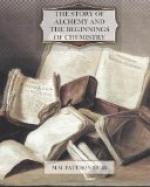Humboldt tells of a parrot which had lived with a tribe of American Indians, and learnt scraps of their language; the tribe totally disappeared; the parrot alone remained, and babbled words in the language which no living human being could understand.
Are the words I have quoted unintelligible, like the parrot’s prating? Perhaps the language may be reconstructed; perhaps it may be found to embody something worth a hearing. Success is most likely to come by considering the growth of alchemy; by trying to find the ideas which were expressed in the strange tongue; by endeavouring to look at our surroundings as the alchemists looked at theirs.
Do what we will, we always, more or less, construct our own universe. The history of science may be described as the history of the attempts, and the failures, of men “to see things as they are.” “Nothing is harder,” said the Latin poet Lucretius, “than to separate manifest facts from doubtful, what straightway the mind adds on of itself.”
Observations of the changes which are constantly happening in the sky, and on the earth, must have prompted men long ago to ask whether there are any limits to the changes of things around them. And this question must have become more urgent as working in metals, making colours and dyes, preparing new kinds of food and drink, producing substances with smells and tastes unlike those of familiar objects, and other pursuits like these, made men acquainted with transformations which seemed to penetrate to the very foundations of things.
Can one thing be changed into any other thing; or, are there classes of things within each of which change is possible, while the passage from one class to another is not possible? Are all the varied substances seen, tasted, handled, smelt, composed of a limited number of essentially different things; or, is each fundamentally different from every other substance? Such questions as these must have pressed for answers long ago.
Some of the Greek philosophers who lived four or five hundred years before Christ formed a theory of the transformations of matter, which is essentially the theory held by naturalists to-day.
These philosophers taught that to understand nature we must get beneath the superficial qualities of things. “According to convention,” said Democritus (born 460 B.C.), “there are a sweet and a bitter, a hot and a cold, and according to convention there is colour. In truth there are atoms and a void.” Those investigators attempted to connect all the differences which are observed between the qualities of things with differences of size, shape, position, and movement of atoms. They said that all things are formed by the coalescence of certain unchangeable, indestructible, and impenetrable particles which they named atoms; the total number of atoms is constant; not one of them can be destroyed, nor can one be created; when a substance ceases to exist and another is formed, the process is not a destruction of matter, it is a re-arrangement of atoms.




